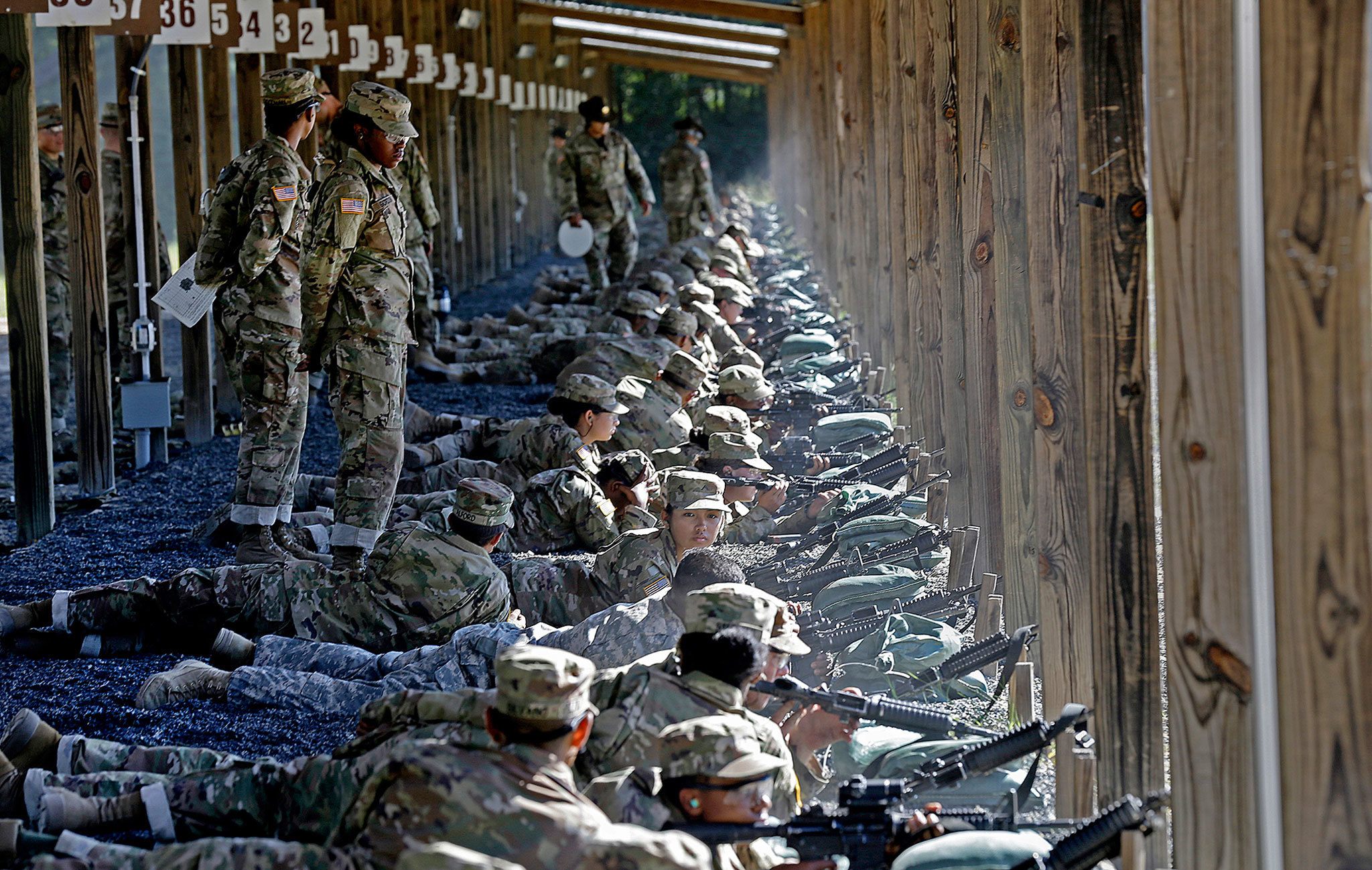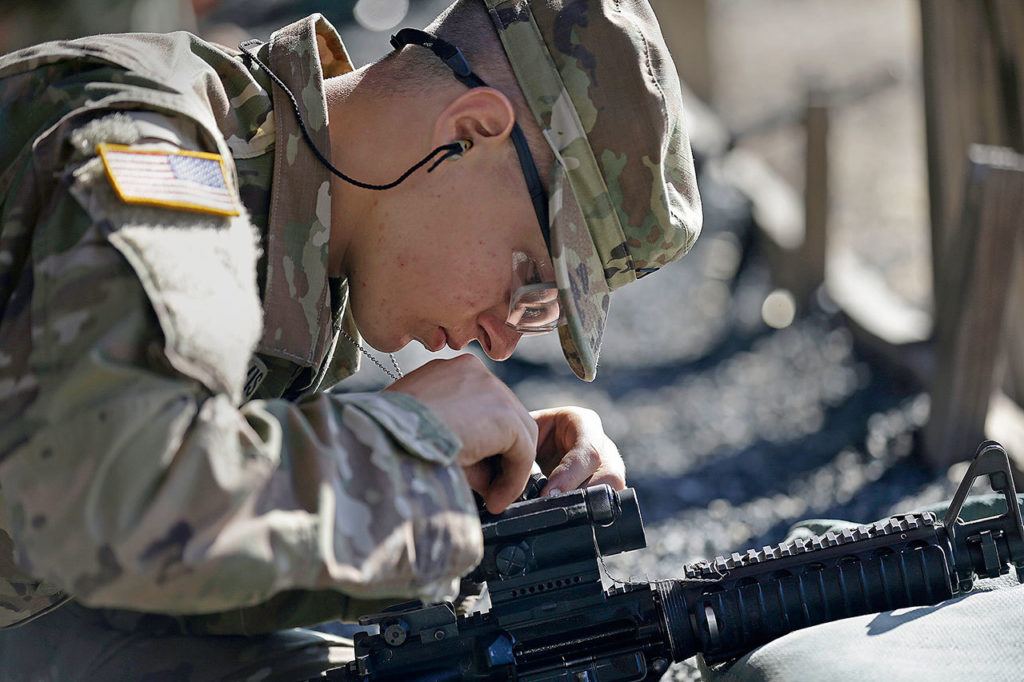Associated Press
FORT JACKSON, S.C. — As gun ownership drops among young Americans and the Army trains a generation more accustomed to blasting out emojis on cellphones than taking aim at targets, drill sergeants are confronting a new challenge: More than half of raw recruits have never held, let alone fired, a weapon.
Young people who form the bulk of the Army’s rookie soldiers don’t have nearly the exposure to guns as past generations. And the drill sergeants tasked with transforming these men and women into competent marksmen are going back into training to adjust their approach. Many are dropping the tendency to bark out orders and are adopting a more mentor-like coaching attitude.
“You don’t hear any drill sergeants yelling, unless it’s a huge safety issue,” said Staff Sgt. Randy Fisher, one of about 600 drill sergeants working daily with recruits at South Carolina’s Fort Jackson, the Army’s largest basic combat training post. “We don’t want the soldiers to get all freaked out.”
Amid deafening blasts of semi-automatic rifle fire at one of Fort Jackson’s 30 ranges, Army drill sergeants paced behind four dozen soldiers aiming M-4s at distant targets during a recent practice session. The hard-nosed, barked commands from the first days of basic training were absent. And though real bullets were being used, not one of the young recruits nor any sergeants wore heavy body armor or helmets.
And, during a lull in the shooting, drill sergeants leaned over to offer guidance in measured tones to soldiers learning to fire.
A study of U.S. gun ownership by an independent research group at the University of Chicago reports gun ownership has declined sharply in recent decades among teens and 20-somethings. This is the same demographic group from which the Army, the largest branch of the U.S. military, draws most of its recruits.
The group called the NORC organization said its study — or General Social Survey — found that among 18- to 25-year-olds, gun ownership fell from a 1977 peak of 45 percent to 13 percent in 2014.
The Army is addressing the issue by blending decades-old fundamentals of marksmanship training for recruits with a “back-to-school” refresher course for some of its most battle-hardened drill sergeants.
The drill sergeants say the new course has helped them work with the younger troops.
“At this stage, we want them as relaxed as possible,” said Staff Sgt. Marc Dorval, 28. “When they come out here, they have a lot to learn, so we take it one step at a time.”
Dorval and Fisher were among the first of the service’s 275 drill sergeants to attend an intensive weapons refresher course for drill sergeants set up at Fort Benning, Georgia.
A nine-year Army veteran with deployments to Iraq, Afghanistan and Africa, Dorval said his refresher course helped him by emphasizing how drill sergeants must become coaches and mentors to teach others to shoot.
“There are a lot of steps that they must accomplish, and we take them one at a time,” Dorval said, noting body position, breathing, and trigger squeeze are all important to shooting accurately.
Dorval said he sympathizes with those who’ve never shot a gun.
“When I joined at 19, I was just a city boy; I’d never fired a weapon,” Dorval said.
Staff Sgt. Harry Lichtenberger, overseeing safety at the “live fire” range, said those new to guns often become the Army’s best shooters.
“We find that those who have fired weapons have quirks, bad habits. Sometimes it’s hard for those who’ve grown up using granddaddy’s rifle to admit they’ve been doing it all wrong,” the 35-year-old combat cavalry scout said.
Recruits are handed unloaded M-4 rifles soon after arriving at Fort Jackson. Some 45,000 soldiers undergo basic combat training here every year, more than half of the men who enter the Army and about 60 percent of its female soldiers. They spend weeks learning to safely handle, clean and disassemble weapons, toting them most everywhere they go.
“We want them to think of it as their third arm,” Fisher explained. After their “live fire” instruction is finished, the soldiers don full combat gear to learn to move with weapons on a battlefield.
And never fear, drill sergeants return to their tough talk, if need be.
Several recruits said the training approach worked.
“I was pulling on the trigger too hard,” said Pvt. Chance Thomas, 19 of Whitney, Texas. He’d grown up hunting small game but had to adjust to aiming the semi-automatic rifle.
Pvt. Lorraina Casas, 18, a first-time shooter, said it took practice aiming through the rifle scope and dealing with recoil. “I’m confident shooting. I’m good at … steady aiming,” said the Fontana, California, native.
Some drill sergeants acknowledge they struggled, too, when first learning to shoot.
“I was horrible! I only made the minimum,” laughed Staff Sgt. Leah Roa, 38.
Her own marksmanship skills increased sharply after her refresher course, she said. “I can tell the ones who don’t do so well to keep practicing their fundamentals. And they can make it,” she added.
Lichtenberger said good marksmanship is a requirement to graduate from combat training for all soldiers, no matter if bound for a combat or support unit.
“All soldiers are soldiers first. No matter what their job, they have to be able to defend themselves and their comrades,” he said.
Talk to us
> Give us your news tips.
> Send us a letter to the editor.
> More Herald contact information.


























